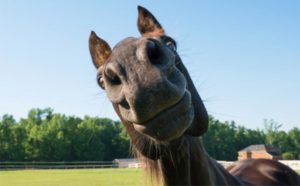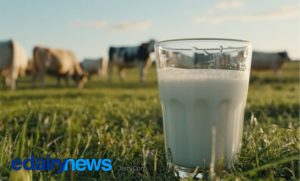Mr McKillop, his wife Belinda and their three children – Angus, Lexi and Marli – operate a 500-hectare dairy farm, milking 380 cows off 200ha and producing three million litres of milk a year.
Their operation is predominantly dryland with a small amount of effluent water used for irrigation.
The Friesian herd is 75:25 autumn-spring calving and the McKillops rear, on average, 150 heifers annually as replacements for their dairy herd, with the excess heifers sold to the export market.
“The export heifer market provides a good line of income each year,” Mr McKillop said.
“Having the excess heifers means we can pick the best and sell the rest.”
Now in September, Mr McKillop says decisions made earlier in the year, in response to a forecast wetter than average spring and early summer, appear to be bearing fruit.
“We are always looking two to three months ahead and trying to be proactive as much as we can,” he said.
In the past week he has cut 700 tonnes of pit silage, which equates to one-quarter of the fodder he plans to store to feed the dairy herd for the next 12 months.
“To get to a point where we have a full year’s supply of fodder – whether silage or hay – would be great,” Mr McKillop said.
“We are hoping at the end of this season to have at least three-quarters of that.”
Having seen the opportunity to grow more feed earlier this year, even with a drier period in July, Mr McKillop switched from using urea and sulphate of ammonia to an nitrogen: phosphorus: potassium (NPK) blend to prepare for an earlier silage season.
On the well-drained soils, it allowed him to get on-site early and take advantage of the season’s good growth.
An unimproved paddock, which had been sprayed out in early August, was ploughed and sown to a forage brassica in early September.
The crop will be used to feed young stock in 10-12 weeks, when feed quality is usually declining.
“I’ve been getting fertiliser out while I can; while the ground is not saturated,” he said.
“If it gets too wet later on, you lose feed quality.
“Keeping the pasture quality high, the cows will milk longer and you have greater control over your costs and profitability.”
It hasn’t been a perfect outcome.
The 2020 autumn had been forecast to be “not that great”.
The McKillops would normally hold over their dairy effluent water to irrigate their pastures in autumn and this year sowed oats and ryegrass into the paddocks as insurance against the predicted dry.
“Turns out we didn’t need it because everything grew,” Mr McKillop said.
“We ended up with feed we couldn’t use.
“We didn’t need to utilise the effluent water as much in autumn, but we have used it in the past three or four weeks because the dam was getting full.”
Mr McKillop regularly looks to Dairy Australia, CSIRO and the Bureau of Meteorology among well-resourced, science-based sources for short-term seasonal and longer-term climate forecasts.
He also looks to historical events and the intellectual capital held by the region’s older farmers for support in making his farming decisions.
“The north east is strongly linked to home-grown pasture production and we have a strong history of working collaboratively in discussion groups and farmer-to-farmer interaction,” he said.
“But you have to be able to apply what you learn from others’ farms to your own farm and understand the context with which their decisions were made.
“Climate forecasting is not a precise science.
“And you can’t farm to the calendar.
“When you see a window, you have got to go.
“Having the ability to pivot means having good relationships with those people who supply you, for example, our silage contractor.”
Mr McKillop returned to north-east Victoria to farm in 2009.
He said the climate was changing year to year with less reliable seasonal patterns and greater extremes of dry conditions and rainfall.
But that change in the north-east alpine valleys might also yield some positives.
“Slightly warmer and drier means we would be able to grow more grass,” he said.
“We expect the summer to be hot and dry but we may be able to grow more feed across more months of the year.”
With that in mind, for the past 10 years, he and other farmers in the area have embraced more tropical species of crops such as sorghum in their feed programs.
Right now, the McKillops, who have three full-time staff working with them, believe their operation is in a “sweet spot”.
“We had 22-23 millimetres of rain on Saturday night and 13mm the week before,” Mr McKillop said.
“Terms of trade are good with a pretty solid milk price; this season that’s nearly 10 out of 10 in terms of growing grass with rain from March until now; cheaper grain and good cow prices.
“We are looking at a little more on-farm storage of grain, giving us the opportunity to take more grain off the header at harvest time when it is the cheapest because grain purchase is one of our main costs.”
Investment decisions are focused on improving operational efficiency.
With 80 per cent of energy costs focused on heating hot water and cooling milk, the McKillops installed a 63kW solar system in September 2019, aimed at reducing their reliance on the electricity grid.
There is also a focus on animal welfare, with the installation of more sprinklers in the dairy yards to keep cows cooler during the summer months, as well as another water trough to provide immediate access to water for the cows as they leave the dairy.
“We are also looking to provide more shelter belts and purpose-built feeding areas with concrete troughs for silage, enabling use to control effluent off those areas and minimise feed waste,” Mr McKillop said.
An $80,000 investment in activity collars for the dairy herd in March 2019 offers insights on how animal health is impacted by extreme weather conditions including summer heatwaves.
“The collars store information every 10 minutes,” Mr McKillop said.
“During one extremely hot night over the summer, their inactivity went through the roof.
“Being able to pre-empt these conditions means next time you have that extreme weather you may change what you feed the cows, where you put them and increase their access to water.”
The North East Catchment Management Authority is undertaking a number of case studies on how leading farmers from north-east Victoria are managing the risks associated with climate change.
This project is supported by North East Catchment Management Authority, through funding from the Australian Government’s National Landcare Program.
The project is working with the region’s farmers to determine how the use of climate projections supports their farm management.











